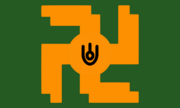Progressive Party (Mel-akkam): Difference between revisions
(→Left) |
(→Left) |
||
| Line 99: | Line 99: | ||
The Progressive Party was historically a decentralised entity, with many factions which ran candidates against each other in general elections. Factionalism decreased in the 1990s before resurging and causing a split in 2022. Today, factionalism is once again prominent, even after the unity pact. Four main factions originally existed: Left, Right, National, and Centre. | The Progressive Party was historically a decentralised entity, with many factions which ran candidates against each other in general elections. Factionalism decreased in the 1990s before resurging and causing a split in 2022. Today, factionalism is once again prominent, even after the unity pact. Four main factions originally existed: Left, Right, National, and Centre. | ||
===Left=== | ===Left=== | ||
Historically the dominant faction, the Left Faction advocates for increased economic intervention and, historically, positive relations with the Eastern Bloc. On the political spectrum, it is considered to be left-wing, with some labelling it as far-left, and is considered to adhere to firmly socialist ideals, with some even labelling it as [[wikipedia:Communism|communist]]. In 2022, it split away to form the '''Progressive Party (Nirtyam Am'mayi)''' before merging back into the main party. 9 members of the Coordinating Council are considered to be part of the Left Faction. It is led by [[Nirtyam Am'mayi]]. | Historically the dominant faction, the Left Faction advocates for increased economic intervention and, historically, positive relations with the Eastern Bloc. On the political spectrum, it is considered to be left-wing, with some labelling it as far-left, and is considered to adhere to firmly socialist ideals, with some even labelling it as [[wikipedia:Communism|communist]]; the faction has desribed itself as supportive of anti-neoliberal [[wikipedia:Socialism of the 21st century|socialism of the 21st century]]. In 2022, it split away to form the '''Progressive Party (Nirtyam Am'mayi)''' before merging back into the main party. 9 members of the Coordinating Council are considered to be part of the Left Faction. It is led by [[Nirtyam Am'mayi]]. | ||
===Right=== | ===Right=== | ||
Revision as of 21:09, 19 February 2024
Progressive Party | |
|---|---|
| Abbreviation | KP |
| Leader | Nirtyam Am'mayi |
| Deputy Leader | Ekabhi Prayam |
| Founded | 1933 |
| Merger of | Progressive Party (Nirtyam Am'mayi) Progressive Party (Ekabhi Prayam) Progressive Unity |
| Membership (2020) | 17,000,000 |
| Ideology | Purogati Pacifism Socialism Factions: Social democracy Democratic socialism Libertarian socialism Anti-neoliberalism |
| Political position | Big tent Factions: Centre to far-left |
| Regional affiliation | Indian National Congress |
| International affiliation | Progressive Alliance |
| Colours | Jade green |
| Anthem | Munduku Veltu Vundu ("Keep on Moving") |
| Coordinating Council | 19 / 40
|
| Provincial Directors | 6 / 10
|
| Provincial Assemblies of Elders | 90 / 200
|
| Party flag | |
 | |
| Website | |
| purogati | |
The Progressive Party (Dravidian: Kaska Purogati, KP), known in 2023 as the Joint Progressive Party List (JPPL), is a left-leaning big tent political party in Mel-akkam. Founded in 1933 by the anti-British activist Maina Kathina as the Progressive Nonviolence Association (Dravidian: Kaska Satyagraha Purogati), the party played a significant role in securing Mel-akkam's independence. It went on to rule Mel-akkam uninterruptedly throughout the 20th century, until it lost power in 2022 and subsequently split. After a year of infighting and chaos, however, the leaders of rival KP factions agreed on a unity pact. The party was reconstituted, and went on to win the 2023 Autumnal Equinox Repeat Election.
Factions
The Progressive Party was historically a decentralised entity, with many factions which ran candidates against each other in general elections. Factionalism decreased in the 1990s before resurging and causing a split in 2022. Today, factionalism is once again prominent, even after the unity pact. Four main factions originally existed: Left, Right, National, and Centre.
Left
Historically the dominant faction, the Left Faction advocates for increased economic intervention and, historically, positive relations with the Eastern Bloc. On the political spectrum, it is considered to be left-wing, with some labelling it as far-left, and is considered to adhere to firmly socialist ideals, with some even labelling it as communist; the faction has desribed itself as supportive of anti-neoliberal socialism of the 21st century. In 2022, it split away to form the Progressive Party (Nirtyam Am'mayi) before merging back into the main party. 9 members of the Coordinating Council are considered to be part of the Left Faction. It is led by Nirtyam Am'mayi.
Right
The Right Faction advocates for economic liberalisation and pro-Western foreign policy. It has been labelled as centrist or centre-left, and adheres to social democracy. In 2022, it split away to form the Progressive Party (Ekabhi Prayam) before merging back into the main party. 7 members of the Coordinating Council are considered to be part of the Right Faction. It is led by Ekabhi Prayam.
Centre
The Centre Faction advocates for moderate economic and foreign policies. It is considered to be centre-left, with some labelling it as left-wing, and is typically labelled as democratic socialist. In 2022, it split away to form Progressive Unity before merging back into the main party. 3 members of the Coordinating Council are considered to be part of the Centre Faction. It is led by Kendra Bindu.
National (Historical)
The National Faction advocated for protectionist and socially conservative policies. It has been described as left-wing, right-wing, conservative, and syncretic. In 2022, it split away to form the Originalist Progressive Party.
Electoral Results
| Election | Votes | % | Seats | ± | Government |
|---|---|---|---|---|---|
| 2023 Autumnal | 112,176,091 | 40.2 | 19 / 40
|
Coalition |